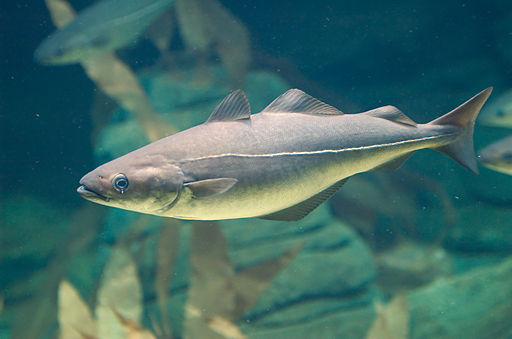In 2019, Maine’s total commercial groundfish landings were valued around $4 million. In 2020, fleets in Maine landed just 58,730 pounds of cod, averaging $2.55 per pound at the dock valued at $149,844, whereas 15.2 million pounds had been landed a decade before.
A 2021 NOAA status update reported that in New England, 13 commercial species are currently considered “overfished” including: Atlantic cod (considered collapsed), yellowtail flounder, Atlantic halibut, winter flounder, and Atlantic herring.
“One problem is that there are so many dogfish out there, and they’re having trouble getting groundfish, over the whole Eastern Seaboard,” says George Parr, a longtime fishmonger at Upstream Trucking in Portland, Maine. In recent years, dogfish have been showing up earlier and earlier in the Gulf of Maine. While dogfish rarely prey on Atlantic cod, studies have looked into whether dogfish populations may be limiting cod, by competition or predation.
“For every hundred pounds of [other] fish they bring in, they bring in 500 pounds of dogfish,” says Parr. “They get 10 cents a pound for it.”
At the Portland Fish Exchange in Portland, Maine, large haddock was $2.26 per pound, while pollock was averaging $1.69 for small, $2.54 for medium and $2.66 for large in early July.
“But right now, large pollock is getting around $3 for whole fish,” adds Parr. “Twenty years ago, you’d be lucky to get 40 cents per pound.” Early July average auction prices for cod were $3.01 for market size and $5.10 for large.
“Cod has been getting less than pollock lately,” says Parr. “Occasionally, cod is $2.35 a pound. And there is not always much on the auction. A lot of boats don’t come here anymore. It’s nothing compared to what it used to be.”
Last year groundfish at the auction was off by as much as 65 percent compared to 2019, because of the pandemic. Parr says he sells a lot of hake and pollock lately. “My customers want good, cheap fish, but that boat sailed.”
In U.S. markets, cod from Iceland is not uncommon.
“That’s what keeps the cod market from going bonkers,” says Parr. “There’s so much from Iceland.” Anecdotal reports suggest Newfoundland and Iceland may be having a banner cod year, possibly because of cooler water temperatures.
Rick Speed, vice president of sales and marketing at Blue Harvest, a New Bedford, Mass., company with a fleet of groundfish boats, says that recent federal programs have helped buoy the groundfish industry.
“Last year, $20 million was allocated by the USDA in a great program for the processors and stakeholders — and for the folks visiting food pantries.” The program purchased pollack, redfish and Atlantic haddock (caught and processed by companies like Blue Harvest) as part of a coordinated effort to supply U.S. food banks. “There seems to be an ongoing demand for it, and it’s a big success.”
One factor the industry is indirectly contending with is skyrocketing freight rates.
“It has not impacted the groundfish market, but it has impacted imports,” says Speed. “If the costs of overseas production are more in balance with U.S. production, U.S. users will lean towards U.S. products. That means we’ve seen great demand for groundfish — but we can’t keep up.”
A positive is that redfish markets — which historically have had limited distribution — have picked up considerably.
“When you’re developing a fishery like we are, it’s promising. The biggest thing for us right now is, we’ve had to get more vessels to process our quota,” says Speed. “Redfish are an underutilized species, and we have a big quota.” Pilot efforts aimed at expanding redfish into the fish and chips market are underway.
“Overall, we see pretty good demand for groundfish,” adds Speed. “We haven’t put as much emphasis on pollock as on redfish.” And along the northeast, haddock seems to be down in both catch and volume this year, compared to recent years. “We don’t know why,” adds Speed. “We’ll wait to see what the surveys say about what’s taking place.”
At Bergie’s Seafood in New Bedford, the focus is on flatfish such as flounder, dabs, and grey sole. A few months back, however, haddock was coming in on fleets, says Phil Mello, Bergie’s general manager, but then it suddenly became scarce. “Maybe it’s the water temperature. It had been fairly steady until about a month ago.” And cod remains scarce. “Boats don’t bring in cod much, it’s a choke species.” Grey sole is up and down, hit or miss.
“Right now, we’re in a bit of a lull, as some boats tie up for a couple of months to go on vacation,” says Mello. “Since many fishermen in this area are Portuguese, some have gone back to Portugal for visits, while other boats have started projects like redoing engines.”
Because Bergie’s supplies distributors that supply restaurants, covid-19 was a hard hit. But things are slowly getting better, as places open back up to half or full capacity. Labor is a challenge nationwide.
“It’s not having a high impact on groundfish,” says Speed, of Blue Harvest, “but ultimately it might translate into higher costs.” Transportation and packaging costs are also higher, however, largely because of the pandemic.
“One package we use is 7-8 weeks out. The problem now is, not everyone has enough help,” adds Mello of Bergie’s. “We supply a large New Jersey chain, and he doesn’t have the help to pick up his freight, his fish!”
One dynamic of the pandemic was a shift to grocery sales. “I think there is some residual that came as a result of that,” says Speed. “A lot of groceries were keeping their regular products, but it opened up the door to other species as well. I think it will be positive for everyone.”







